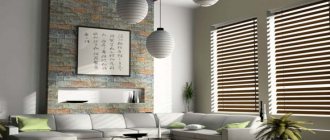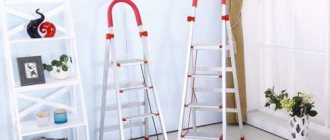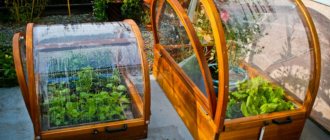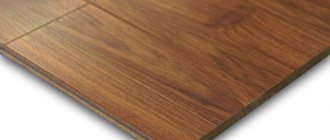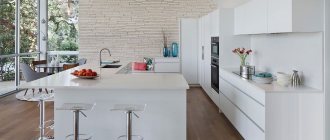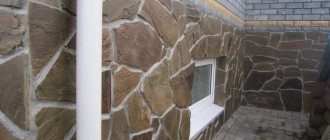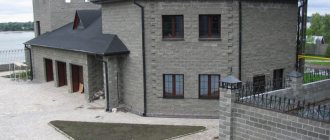Decorative moss in the interior looks incredibly stylish and literally enlivens any room. This material is used to lay out small inscriptions on walls and large-scale green compositions, decorate furniture and decorative items, and create original phyto-paintings. Live or artificial moss will fit perfectly into the interior of an apartment, country house or public space. They can decorate the walls in the living room, the cooking area in the kitchen-dining room and even the bathroom. A living moss wall will certainly evoke a feeling of peace and unity with nature.
Features of use in design
Initially, living walls or decor were made from natural forest lichens: but this option was quickly abandoned because moss in apartments required too much care - from maintaining high humidity to constant watering and spraying. To simplify the task, the plants began to stabilize.
Stabilized moss is a natural material that has undergone a “preservation” process, allowing it to retain its original appearance and softness for a long time.
To create interior decor from living moss, natural plants of various types are collected. The standard raw material is Cladonia, a lichen widespread in forests, tropics, and deserts. After assembly, stabilization is carried out: moss is soaked in a saline solution, and dye is added if necessary.
Advantages:
- Easy to care for. A living wall or painting does not require feeding or watering.
- Aesthetics. The green composition retains its original appearance for a long time.
- Large selection of colors. Stabilized moss can be not only green, but also yellow, orange, purple, etc.
- Environmental friendliness. Although the moss is processed, it is as natural as wild plants.
Flaws:
- Demanding on the environment. Severe frost, as well as direct sunlight, negatively affect the condition of natural decoration and shorten its service life.
- Fear of water. The ingress of liquid destroys preservatives, and therefore the moss itself. This fact somewhat limits its use, but the stabilized material can be replaced with artificial moss.
- Limited service life. Even under ideal conditions, greens will only last 6-9 years, after which they will begin to dry out and crumble: the raw materials will have to be replaced with fresh ones.
Regarding the use of moss in the interior, a reservation should be made: greenery is suitable for almost all styles. But eco, loft, Scandinavian, Japandi, boho, country look especially good.
Kinds
Different types of decorative moss are used to decorate the interior:
Plastic
The most affordable material. It is a fleecy flat mass. It is mainly used for wall decoration. The material can also serve as a background for a drawing on a round panel. It is recommended to choose products made from plastic moss for decorating the bathroom and other rooms with high humidity.
Reindeer moss
Also known as reindeer moss. It has a fluffy and voluminous structure. Resin moss is obtained mainly in Norway, growing it on special farms. Resin moss is soft, pleasant to the touch, elastic, easily absorbs unpleasant odors and can be restored. The disadvantages include the fact that if not properly cared for, it quickly dries and crumbles.
Kochkovy
From the name itself it is clear that this species has a convex hummocky structure. It is used to create three-dimensional compositions. It attaches well to the surface and is well suited for forming relief paintings. The main disadvantage of hummock moss is its high cost, so it is not often used for indoor decoration.
Advantages and disadvantages
Since living moss in the interior is quite difficult to care for, designers in their work most often choose a stabilized plant, all of the liquid of which is replaced with a special solution based on glycerin.
The decorative element can be created from moss, sphagnum, oak moss, or one that has stems or fibers.
- This natural element is absolutely safe for the health of apartment residents. It is environmentally friendly and does not cause allergies. Correctly carried out preservation also deprives it of its specific smell, and thanks to “freezing” there is no need to worry about the appearance of midges and bugs.
- A stabilized plant is dormant, and therefore it does not rot, decompose or dry out. This means that the decorative element can please the eye for about 10 years. All this time, the moss will retain a bright green hue, without turning yellow or darkening, but if desired, the plant can be painted in any color.
- The canned crop does not need to be watered, and, being universal, it is suitable for decorating any room. A relative disadvantage of this material is its high cost, because you will have to pay for conservation.
- Living moss, as mentioned above, requires quite complex care and does not last long, but such a decorative element is practically free - just find a suitable hummock in the forest and bring it home.
What does stabilized moss mean?
This is a unique method of preserving living moss. That is, live moss is taken and soaked in a special solution in order to preserve it in a special way and make it more convenient for further manipulation.
Stabilized moss can be made from different types of moss. It is quite possible to make stabilized reindeer moss, sphagnum moss, moss with stems and leaves, moss in the form of fibers or oak moss, which is more like algae.
Most often, designers choose stabilized reindeer moss, since it is easier to get in our latitudes. It looks cheerful and green and can decorate almost any interior.
Stabilized lichen moss
Stabilized reindeer moss is ideal for creating home frame sculptures and panels; if desired, it can even be attached to the ceiling.
Also especially popular are moss hummocks, which can be placed in different areas of the apartment to give it a special fabulous atmosphere of an ancient forest.
Stabilized moss in lumps
Interior wall design
Most often, stabilized moss is used to decorate surfaces, or more precisely, walls. Green panels can be placed in one zone as an accent, or they can be used to decorate a couple of adjacent verticals. Options are unusual when stabilized greenery does not form a complete canvas, but alternates with hummocks, branches, stones, pieces of wood and other natural materials.
Again, the surface can be completely filled with moss or you can use it to lay out inscriptions, drawings and patterns. In the bedroom it would be appropriate to use vertical or horizontal stripes of moss. This solution will not only enliven the space, but also visually enlarge it. In addition, it is customary to decorate the room with greenery on the wall at the head of the bed.
In the bathroom, the material will look good as an independent panel, located away from direct contact with drops, or as a frame for mirrors.
To prevent the room from looking like a swamp, the amount of plant used must be balanced. By the way, it is important not to fall for the tricks of non-professionals who suggest adding a rug made of stabilized moss to the room. This material is very delicate and will easily collapse if you press on it with wet feet.
The kitchen is an area in which surfaces often suffer from splashes of liquids, grease and food, and therefore it is not entirely reasonable to place a green canvas in it from floor to ceiling. But an interesting idea would be to draw a small picture with a special mixture on any dry, rough surface. You can implement your idea by combining a couple of handfuls of moss, 2 cups of kefir and the same amount of water, half a teaspoon of granulated sugar and corn syrup.
The washed plant is blended with the first three ingredients, then corn syrup is added until a consistency similar to oil paint is achieved.
In the living room, the material is suitable for decorating an accent wall. Both fleecy layers reminiscent of a lawn and a combination of different textures interspersed with ivy, fern and dried flowers will look great.
If you want to add volume to the composition, you should use stabilized hummocks.
Small compositions and decorative elements using stabilized moss
Using moss, you can create interesting compositions that will bring freshness and variety to the interior. Such decorative elements can be made independently either from stabilized moss or from regular moss collected from the forest.
Oasis on the interior walls
A new trend in interior decor is a phytowall. Moss has both its advantages and disadvantages. It is very pleasant to the touch, looks great on the wall, especially under sliding lighting, and absorbs sound perfectly. But if you are thinking about creating such a living oasis, it will cost a pretty penny, considering the cost of stabilized moss.
Furniture using stabilized moss
Craftsmen thought of using moss not only on clocks and walls, but also furniture was transformed using living plantings. I don't think it's practical, but ideas have a right to life.
How to stain moss?
As previously mentioned, a solution of glycerin with warm water discolors the moss fibers and dye must be added to it so that the plant does not lose its bright green color. But who said that you can’t use other colors: yellow, red, even purple? Similar color solutions will look great in a non-standard room design in the “pop art” style.
You can use available materials as a dye: children's paints - watercolor or gouache, or regular food coloring. You can create several solutions at once and determine the effectiveness of each through experiment.
Moss decor in the interior: what can be made from this plant
You will be surprised when you see how the interior is transformed with moss. From this material you can make inspiring green inscriptions on the walls, transform furniture, and create unique compositions that are sure to become a bright touch in the design of the room.
You can effectively use moss in the interior of any room - in the living room, dining room, kitchen, bedroom, on the balcony and even in the meeting room in the office.
In the kitchen
Moss in the kitchen interior will set you up for positivity from the very morning. Eating food will be much more enjoyable, even if something goes wrong during the cooking process. See how you can decorate the room:
Moss can be used as accent walls in the kitchen and dining room. They will help zone even a small room, visually transforming it. Walls covered with moss will become even more beautiful and brighter if you use small paintings and photographs in frames, spotlights or pendant lamps for decoration.
In the cooking area on a vertical surface, you can create a fastening system for the necessary kitchen utensils. They will look great against the background of a living wall made of moss with your own hands.
This is interesting: Many people are afraid to use moss for kitchen decoration, believing that the material smells unpleasant. Let us dispel your fears - the specific smell of the plant is felt only in the first days after installing the composition. And if you choose artificial material for decoration, you will not encounter such a problem at all.
In the living room
Moss in the living room interior will be a successful design idea. It is best to place a green composition opposite or next to the sofa. You will see that all your worries will quickly fade into the background when you lie down to rest and admire the living wall for a couple of minutes.
- A living wall made of moss, made with your own hands or ordered from specialists, will look impressive in a spacious living room. This decor can be combined with various styles - modern, loft, eco, ethno and country.
- If you are afraid to overdo it with green color in the interior, opt for narrow panels, panels and phyto-pictures. The panels can be installed on either side of the fireplace or home theater, and moss paintings can be hung between windows or above the sofa.
Tip: Where it is better to place moss paintings is up to you to decide. It all depends on the shape and size of the products. For example, if the interior is dominated by strict and laconic forms, choose square or rectangular phyto-pictures. From these, you can assemble an original composition on the wall by placing the elements in random order.
In the living room of a small apartment, you can use compact moss compositions - for example, moss in an aquarium or florarium. This piece of decor will look beautiful on a coffee table. Moreover, the original composition can be made independently in one evening, and the elements of the composition can be easily selected to suit your taste.
Both natural forest moss and artificial material are suitable. Get inspired by designers' ideas before you start creating:
In the bedroom
The interior of the bedroom can also be decorated with live compositions. For decoration, it is better to use narrow panels made of stabilized or artificial moss, phyto-paintings or clocks. Many people prefer to decorate the walls next to the bed in this way - most often at the headboard.
This is interesting: Some believe that freeze-dried moss in the interior can provoke allergic reactions in residents. It is for this reason that people hesitate to use it when decorating bedrooms and children's rooms. Allergy to moss is a myth. You can decorate any room with stabilized moss without worrying about the health of your loved ones.
In the bathroom
High humidity has a beneficial effect on living compositions, which is why designers often use moss in the interior of the bathroom and toilet. For the bathroom, you can choose various design methods - from a large green composition on the entire wall to a compact rug that will look great next to the shower stall.
Stabilized moss can be combined in the bathroom interior with other decorative elements.
Against the backdrop of evergreens, illuminated mirrors, spotlights and pendant lamps, functional shelves for hygiene products and racks for towels look impressive. Look how designers designed a small bathroom:
On the balcony
A balcony or loggia can also be made more beautiful by installing a green composition made of moss, natural or artificial flowers. This design will enliven a space made of metal-plastic, wood and glass. See how designers use moss decor in the interior of a balcony:
Before you make a moss wall on the balcony, you need to choose the right material. If your apartment or house faces the sunny side, then it is better to choose artificial moss. It looks almost the same as natural and requires no maintenance.
Stabilized material is not suitable for decorating a sunny balcony - under the influence of ultraviolet radiation and elevated temperatures, the plant will quickly lose moisture and lose its attractiveness.
Tip: If the balcony is long and narrow, use pallets with stabilized or artificial moss, small panels, inscriptions or honeycomb shelves with moss on the wall as decoration. This design option allows you to decorate the room without cluttering up the free space.
In the office
Any public space, be it an office or a store, will become more attractive if you use moss decor. There are many design options - from large green compositions covering the entire wall to original furniture with stabilized moss under glass. See how designers use moss in the interiors of shops, hotels and offices:
If you want to make a wall from natural material, then it is better to think in advance about who will take care of it. The room needs to maintain a certain humidity and optimal temperature. It is better to place the wall away from heating appliances. The optimal location for such decor is in the hall or meeting room.
Tip: Use different shades of material to make your living arrangement more attractive. White moss on the wall goes well with traditional green. If desired, you can put the company name or brand logo on a vertical surface - with the help of stabilized material, painted in different colors, anything is possible.
Furniture with moss elements will look great in meeting rooms and halls. Some designers offer a rather bold approach - replacing traditional furniture finishing with natural materials. This is not entirely practical.
But placing live moss under the glass of a coffee table is nothing at all. Look what this decoration looks like:
Quite often, Icelandic moss is used to decorate public spaces. It is placed under glass, in florariums, or original panels are made from this material. Such decorative items will be an excellent decoration for the manager’s office:
Moss inscriptions
We offer two ways to complete the inscription:
By gluing moss. First you need to draw the letters on paper or print a template from the Internet. Letters are cut out of a layer of moss according to their size and fixed on the wall using double-sided tape.
Using the mixture described above. The easiest way to write is using a stencil.
Rules of care
Since experts recommend using stabilized moss in the interior, we will talk about caring for this species.
The correct choice of location of the element in the apartment plays an important role. Moss does not react well to low temperatures and also does not tolerate direct sunlight.
- It cannot be watered, sprayed or fed, but it loves high humidity - the green panel will “feel” good even in the bathroom. By the way, the ideal humidity is approximately 40-70%.
- If in winter the air in your apartment dries out due to running batteries, then you should think about an air humidifier.
- Natural decor usually does not attract dust, but if it does appear, then it will be enough to treat the surface with a broom with soft fibers.
How to care?
The care process depends on the type of moss.
- Live moss. At first, a growing green garden is watered daily: when the plant takes root, watering is reduced to once every 3-4 days, but sprayed every day. It should be placed in a shaded place with high humidity - it is better to place a humidifier or a vessel with water (for example, an aquarium) nearby.
- Artificial. Any non-living plants are dust collectors, so from time to time the decorations will have to be vacuumed or washed with a damp sponge.
- Stabilized. Keep away from ultraviolet radiation, frosty air, and water. Dust is removed with cold blowing - from a hairdryer or vacuum cleaner with reverse draft.
Lettering on the wall made of decorative moss
Stabilized plants are suitable for creating short texts. Decorative volumetric letters have a velvety surface, look original on the walls and attract people's attention. Companies use eco-logos or green signs to stand out from competitors. The cost of jewelry depends on the complexity and volume of work, on average - from $170.
At home, you can make a decorative inscription yourself. Add to blender:
- live moss – 3 handfuls;
- kefir – 1 glass;
- soaked hydrogel – 2 tbsp. spoons;
- sugar –2 tsp.
The composition is mixed for two minutes until smooth. The contours of the inscription are applied to the cleaned surface. The brush is dipped into the resulting paste and gently brushed over the text. Every 3 days the pattern is sprayed with water from a spray bottle.
The lichen grows into the base, becomes established and actively develops. Landscaping grows best in the shade, so it is protected from bright sun.
Decorative moss for the garden
In landscape design, moss is used to decorate the garden. The plant does not require care, develops quickly and recovers from unfavorable conditions. Using low-growing species, you can disguise protruding tree roots and ugly stones, or decorate a statue or bridge. The dense green covering in the recreation area looks like a velvety carpet.
Decorative moss on a stone Source kitchengardenr.com Moss decorations in the garden Source kvartira.mirtesen.ru
Moss prefers to grow in shady areas of the garden. To make the plant take root faster, it is recommended to increase the acidity of the soil with peat. In the heat, the culture stops developing, so in the evenings the surfaces are sprayed with water from a spray bottle. During the winter, it is prohibited to whitewash tree trunks on which living decorations are located.
Moss decor on stone Source yandex.uz Decorating tiles with decorative moss Source bing.com
To decorate the landscape, designers often use moisture-loving cuckoo flax with tall stems. Flowering hybrids include white and Anders saxifrage. Externally, the crops resemble bells on thin legs that stand above the moss. For vertical gardening, low-growing dicranum, which prefers coniferous trees, is suitable. The fern variety helps to create dense openwork thickets on the site. Peat lichen has variegated shoots and loves sandy soil.
A carpet of moss under the trees Source tr.pinterest.com Blooming type of moss Source yandex.ru
Moss rockery Source teresasplants.com
Moss clock
An original accessory suitable for eco-style interiors. Externally, the decoration resembles a plant painting with a wooden baguette. A decorative element made of preserved reindeer moss with hands and a dial operates on batteries. The most common frame shapes are circle and square, although there are options like:
- hearts;
- semi-ovals;
- characters.
In design studios, jewelry costs from $100. Like moss walls, you can make a living clock yourself. The mechanism with arrows is mounted to a base (made of wood or plastic). Stabilized reindeer moss is glued to the board with PVA glue, the remaining substance is removed with a dry cloth.
The accessory is placed away from heating devices and directed sunlight, otherwise the plant material will darken.
Pros and cons of moss
Spore plants certainly look original and can complement any room style. Other benefits of using them include:
- ease of use (suitable for decorating walls, interior elements, landscaping);
- wide range of colors (from light green to blue, black);
- long-term preservation of the brightness of the material (do not fade, do not darken)
- flexibility of raw materials (suitable for decorating smooth surfaces, and for creating products in the shape of balls and cones).
The disadvantages of spore plants include high and average cost. Budget polymer products are cheap, but they don’t look as impressive in design. Natural, unstabilized plants require periodic spraying and fertilizing. In addition, due to high moisture, they can lead to mold and mildew. Natural spore-bearing plants are not recommended for indoor use.
How to stabilize or preserve moss?
Stabilized moss can be ordered in online stores in both the CIS and on Amazon. But if you don’t want to say goodbye to your hard-earned money, then you can stabilize the moss Yagel yourself:
- Clean moss from natural debris;
- Leave the moss in a container of cold water for 2-5 minutes to soften it;
- Dry the moss on paper towels;
- Dilute 1 liter of glycerin with 3 liters of hot water in a plastic container and stir thoroughly until the glycerin is completely dissolved;
- Add 200 ml of color to 2 liters of solution;
- Immerse the dried moss in the solution so that it is completely covered;
- We seal the plastic container and leave it for preservation for 12-15 days.
Moss for decoration: where to get it and how much it costs
Plants are soaked in a special glycerin-based solution for 2-3 weeks. Chemical components from the tissues displace water, as a result of which the moss becomes stabilized. To prevent the decor from losing color, food coloring is added to the liquid. Preserved decoration does not need to be watered or illuminated. If you follow the rules of care, it does not lose its attractiveness for 5-7 years.
Ready-made stabilized material is offered by design and landscaping studios. Three types of decorative moss are used for decoration:
- Reindeer moss. Fluffy, beautiful coating is appropriate for creating voluminous and textured compositions. A square meter of decoration costs from $260.
- Moss in layers. The decor has a fleecy structure and looks like a lawn. Used as a basis for phytowalls. The average price is 130 euros per 1 sq. m. m.
- Stabilized by hummocks. Material with a dense texture is used to create art objects to match the natural landscape. For a square they ask to pay from 35 thousand rubles.
Fluffy moss from reindeer moss Source usgardendesignideas.blogspot.com
If you need to decorate a small area, then purchase moss in packages of 400 and 500 g. Resin moss costs from 18 to 40 dollars per pack. For a flat decor they want from 45 euros, for a fluffy tussock look - from 50 to 70. The high cost is compensated by the beauty and durability of the preserved plants.
Moss after stabilization Source growtool.ru
See also: Catalog of companies that specialize in interior redevelopment.
Myths
Myth No. 1: Moss will rot right on the wall.
Can the moss that we are offered to use in interior design actually rot? Yes, if the biological processes in it are not stopped. But stabilized moss in the interior will delight you for many years without losing its decorative effect if it was processed by professionals without violating technology. Unfortunately, more and more amateurs are appearing in this area, whose only goal is to earn more money and “dissolve in the fog,” so it is better to contact a company with a good reputation, a rich portfolio, and many satisfied clients.
Myth No. 2: moss will not take root.
Moss cannot help but take root for a simple reason: it “sleeps”. All biological processes in it are stopped. The state of stabilized moss can be considered “cryogenic freezing”. All the liquid is drawn out from the plant, and instead of it a special solution is pumped in, thanks to which the plants in the interior become unpretentious, but visually alive.
Myth No. 3: There will be midges or other insects
Moss does not attract insects. Midges do not circle over it, beetles do not appear, since all biological processes in it are stopped.
Myth #4: Moss will turn yellow or black.
What color is the moss in the interior? In most cases, customers choose lush green moss to decorate their premises - in nature it is usually gray-white. If you don’t have enough color or accent in your design, you can choose moss of any shade - it is painted with safe paints in production. It is the color of moss with which it appears on your walls that will delight you throughout the life of the plant. Properly stabilized moss cannot turn black, yellow or gray. It is important to note that it is also resistant to mold and mildew.
Myth #5: Moss will start collecting dust.
Do not worry! Your moss wall panel will not turn into a “dust collector” because stabilized decorative moss repels dust due to its density and texture. It collects no more dust than a bathroom curtain. But if you do find it, you can gently brush it off with a pipidaster.
Myth #6: Moss needs to be looked after
Do green panels in the interior need maintenance? No. Stabilized moss does not require watering, cutting, spraying or fertilizing.
Myth #7: Preserved moss is artificial moss.
Stabilized moss is the most natural moss. Just "sleeping". Thanks to special technologies, stabilized plants do not lose their elasticity, beauty, softness and shades. In a “dormant” state, they will delight you for up to 10 years.
Myth No. 8: Moss will die without light.
Moss does not require sunlight; its growth processes are stopped. It can easily be used even for decorating basements. Moss does not require any natural or artificial light sources. But if you want to emphasize the beauty of panels or other moss compositions, you can use decorative lighting.
Myth No. 9: Moss is dangerous for the health of children, allergy sufferers, and pets.
If you decide that your interior urgently needs eco-design, one of the first thoughts will most likely be this: isn’t stabilized moss dangerous? You can safely decorate your interior with it - moss is not hazardous to health, does not cause allergies, and is non-toxic. It is important that pets are usually no more interested in moss than they are in paintings on the walls.
Myth #10: Moss will dry out.
Stabilized moss does not dry out or fall off. But during the heating season and if it is close to heating devices (compositions with moss should be placed away from them), it may slightly lose its softness and elasticity. Don’t panic and don’t even try to touch or frantically water the stabilized moss - you’ll only harm it. The best thing you can do is to increase the humidity level in the room. Remember that a stabilized plant will regain its softness on its own as soon as the indoor humidity levels return to normal.
Myth #11: Moss smells bad.
Moss, of course, has its own smell, but it is not pronounced and will only be slightly noticeable in the first days of installation. Moss compositions will not cause you any problems.
Myth No. 12: if a child ruins a moss arrangement, it can be thrown away
Did the kids nibble a little on your fantasy wall or moss panel? Dont be upset. The specialists who create this green beauty can also repair it. Or give you a box of moss with repair instructions, although this is more difficult - it requires experience and dexterity.
Myth No. 13: Moss panels cannot be placed outdoors
Can. But in such a way that your fluffy wall is protected from direct rays of the sun and from rain.
Myth #14: Moss should not be placed in the bathroom.
Indoor humidity has a beneficial effect on the plant and its lifespan. This has nothing to do with spraying and watering - they are strictly contraindicated for stabilized moss.
Myth No. 15: Lighting is harmful to moss
LED lamps are the ideal solution if you decide to highlight moss. It does not heat up and does not dry out the moss compared to incandescent lamps.
About the material
When choosing suitable mosses, you need to understand their differences and placement rules. The three main groups include:
| Artificial | It is a non-living plant that is used solely for decoration. Requires careful removal of dust, since any contaminants can accumulate in its structural surface. It is usually made from plastic or derivative raw materials. |
| Alive | The plant that needs to be sprayed can be used in sunny and shaded areas. Usually reindeer moss is used to style rooms. This variety has a bright light green color. |
| Decorative | This moss is a cross between the species described above. It does not need spraying. Unlike the first type, it is created from a natural plant, and not from plastic or polymer materials. |
Interior options with stabilized moss
If it were not for the green panel on the wall, the living room in white would look very boring. The composition is quite large in size, enclosed in a laconic white frame and illuminated by several lamps. The moss itself on the panel is combined with other natural elements.
A snow-white classic sofa, light walls and light gray interior details become the ideal backdrop for an unusual decorative element.
- The modular panel located at the head of the bed looks very advantageous. The composition is made up of 9 green squares in wooden frames, arranged 3 in a row. The panel echoes the bright green carpet and other decorative elements. Wooden panels on the walls in combination with moss create a cozy “forest” atmosphere in the room.
- A simple living room in black and gray tones will sparkle with new colors if you place a coffee table with vegetation under glass. Successfully harmonizing with some of the existing decor, this particular item gives the room liveliness.
- Another interesting option would be to add a moss wall in the bedroom next to the bed. This solution makes it possible to visually delimit the room and create a separate zone. A nearby comfortable yellowish chair, several lamps and a wooden console suggest that this place is intended for reading.
Application options
Moss in the interior of an apartment can look completely different, but the main use case was, is and remains a wall made of moss. Large surfaces covered with moss look incredibly stylish, refresh any interior, and create a feeling of closeness to nature.
Phytowalls can be different: they occupy space from corner to corner, and are decorated only with individual vertical or horizontal stripes, protrusions, niches, columns.
Walls usually play an accent role, highlighting certain areas in the room.
The second most popular method of application in the interior is paintings made of moss. Solutions can be wall panels with a textured surface, framed paintings, wooden panels of unusual shapes, complemented with decorative moss.
In addition to the classic shapes: square, rectangle, circle, wall decor can be made in the form of an animal, inscription, star, heart, tree, flower.
Advice! Decorative moss on the wall can also be functional: for example, if you use it to decorate a clock.
The photo shows wooden panels with greenery
A wall made of moss is not the only option for using it in the interior. If you are looking for an unusual mobile decoration, take a closer look at compositions in flowerpots, glass florariums, and vases.
On the table you can place a “lying” flat panel with a scene you like: for example, in the form of a fairy-tale forest or a beautiful clearing.
You can also decorate furniture with stabilized moss: unusual inserts in a shelving unit or a green “river” in the tabletop will turn ordinary home furnishings into original ones. Living moss is also used to make bathroom rugs.
In the photo there are green inserts in the zoning partition
